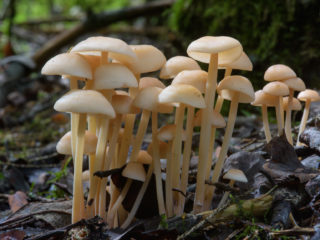Content
The mushroom kingdom is very diverse. In the forest you can find mushrooms that look like barrels, flowers, corals, and there are those that are very similar to graceful ballerinas. Among the fungal representatives there are often interesting specimens. Xerula root looks very original, thanks to its thin, long stem and miniature cap.Very often, mushroom pickers do not collect this species, not knowing that the mushroom is edible and contains a large amount of useful substances.
What does Xerula root look like?
Xerula root, or Collibia caudate, attracts the eye with its interesting appearance. A small, miniature hat sits on a very thin, long stem. Root Xerula resembles a nail driven into the ground.
Description of the cap
Due to the long thin stem, the cap seems small, despite the fact that it reaches a diameter of 2-8 cm. In young specimens it is hemispherical in shape, straightens with age, becomes flat, while maintaining a small tubercle in the center.
The wrinkled surface is covered with mucus and colored olive, dirty lemon or dark gray. The lower part has smooth, sparse plates, painted snow-white or cream.
Description of the leg
Xerula root has a long thin stalk, which reaches a length of up to 20 cm, a thickness of about 1 cm. It is buried 15 cm in the ground, is often intertwined and has a specific rhizome. The fibrous pulp is covered with numerous scales, which are snow-white at the base and gray-brown closer to the soil surface.
Is the mushroom edible or not?
Xerula root is an edible species that has medicinal properties.
Beneficial features:
- The culture liquid contains the substance udenone, which is involved in the metabolic process and lowers blood pressure, so the mushroom culture is recommended for use by hypertensive patients. The species is very popular in China; Chinese doctors use it in folk medicine to treat hypertension.
- The pulp has antibacterial properties, udemansin-X actively fights yeast and mold fungi.
- The mycelium contains polysaccharides that stop the growth of cancer cells.
Features of use
The pulp of Xerula is root, light, watery, odorless and tasteless. The mushroom can be eaten fried or pickled. Before cooking, the mushroom harvest is thoroughly washed and boiled. To add flavor, spices and herbs are added to dishes.
Where and how does it grow
Xerula root prefers to grow in coniferous and deciduous forests. It can often be found on stumps, rotten wood, and in half-rotten, moistened rot. Mushrooms can grow singly or in groups; fruiting begins in mid-July and lasts until the end of September.
Doubles and their differences
Xerula root has 2 counterparts:
- Edible - Xerula is long-legged. This species has a thin long leg and a velvety grayish cap.
- Poisonous - Pluteus scaly. In terms of external characteristics, they are very similar, but they have a difference - the lamellar layer of the false twin does not reach the stem.
Conclusion
Xerula root is an elegant, healthy mushroom that grows throughout Russia. Due to the medicinal properties of Xerula root, it is widely used in folk medicine. Despite the watery pulp and lack of taste, the mushroom is used to prepare many dishes.














